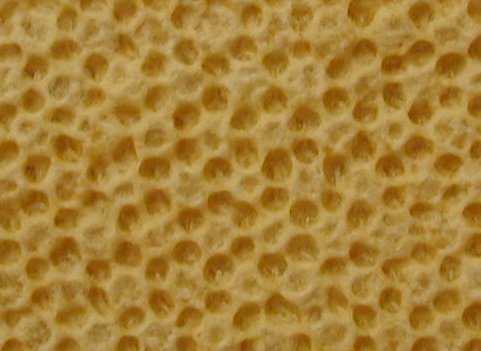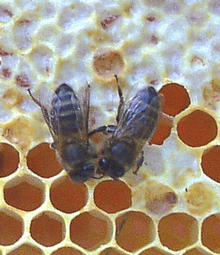Bee Behaviour - Index
Zachary Huang's Website
|
|
|
|---|
|
Bee Behaviour - Index Zachary Huang's Website |
Rosette Capping Behaviour in Honey Bees |
|---|
On 3rd June 2003, Zachary Huang (Assistant Professor of Apiculture, Michigan State University) Emailed the BEE-L discussion list with the following subject line... "Strange brood capping -- for your eyes only :)"
Has anyone seen this kind of strange capping?

I just got lucky! I saw this again (after 3 years!) today and I will try to freeze it to take some measurements. Perhaps swap the queen later also to see if it is genetic or not. Unless it is related to being in an observation hive... I do not see how light could have induced it though. almost as if the bees are trying to save on wax (but does the sunken cappings use less wax?).
very pretty pattern though.
Zachary
I replied...
Hi Zachary & all
My calendar does not say April 1st, so I suspect some other sort of leg pull. It is the sort of pattern that could result from pin killing in the rosette shape rather than the diamond shape, but if the larvae are alive and develop into full size adults that is ruled out.
The only guess that I can make is that the larvae in the cells that are at the centre of the rosettes emitted some sort of pheromone that inhibited/stunted the growth of the larvae in the cells surrounding it.
> trying to save on wax (but does the sunken cappings use less wax?).
I would suggest that if the capping is de-bossed by the same amount that it would normally be
raised then wax usage would be the same. If the sinking is deeper than this, then more wax
than normal would be required.
Dave
The conversation carries on...
NO, the frame was from an observation hive and we never tried pins on pupae yet.
The only guess that I can make is that the larvae in the cells that are at the centre of the rosettes emitted some sort of pheromone that inhibited/stunted the growth of the larvae in the cells surrounding it.
Good hypothesis, but it does not explain why exactly 1 out of 7 would be inhibiting others. Also, inhibited growth should not resulting in different capping, only later capping.
I guess I will need to:
1). take the frame out
2). map the normal brood with cellulose paper.
3). emerge them in an incubator to see if there any difference between the two kinds of cells.
4). create some small cages, and cage the one bee in the center, others cage the surrounding
6 bees (perhaps by killing the center one), or if I get lucky I can wait for bees to emerge
and grab them in real time.
5). measure and weigh these newly emerged bees to see if they are different (size and weight).
6). measure cell sizes after bees are out to see if the cells maybe slightly larger in the
center cell.
Any other ideas? I will probably remove the brood sometime this week (so you are participating in an experiment in real time if your input is useful). The observation hive was installed May 23, from a swarm (of known colony source so we can check the natal colony for the same brood pattern too, if so it would be maternal effect).
> but it does not explain why exactly 1 out of 7 would be inhibiting others.
It is not one out of seven... the pattern is repeated, overall it is about one to two
The pattern could originate due to the sunken cells coming under the influence of two non sunken cells with a 'fall off' of effect being so steep that it takes two cells (one either side of a sunken one) to create the effect in the first place.
> Also, inhibited growth should not resulting in different capping, only later capping.
Are the moults governed by elapsed time or volumetric increase? I would have thought that growth could be stunted, but occur in the same developmental stages and same timing.
Yes I was wrong. I actually counted cells and it is one out of three (60 normal cells, 120 sunken cells)!
still it does not explain why one would be normal out of three, in such a regular pattern. I suspect that the foundation is duracell.
Are the moults governed by elapsed time or volumetric increase? I would have thought that growth could be stunted, but occur in the same developmental stages and same timing.
I see your point. I am not sure either if smaller larvae would result in lower cell capping in worker brood. in the spring you see a lot of pigmy bees, perhaps because insufficient pollen, but they all seem to have normal capping to begin with.
You will find out when you measure, but the 'sunken' cappings may be 'normal height' and the middle ones could be deeper cells than they should be.
I find it intriguing and look forward to you being able to find significant answers in due time.
From: James Fischer
Subject: Re: Strange brood capping -- for your eyes only :)
Have these patterns shown up only in your observation hives?
Perhaps only on the side towards the (stronger) light source?
I am reminded of a moire pattern when I look at the cells, and I wonder if the effect is unique to an observation hive environment, and would not appear in a normal (dark) hive or an observation hive with a cover over the glass.
Consider the heat more than the light.
|
At that point the conversation was dropped , but in January 2005, I was looking at a recently produced website belonging to the Mid Ulster Bee Keepers and on a small image (shown right) I noticed what I thought might be a similar pattern of capping. So I Emailed the website compiler Sir Frederick Hazelton-Kullas to see if there was a picture that covered a larger area of the comb. And as luck would have it, a large version giving more detail was Emailed by return. The bees were bred near Limavady, NI, near the north-west coast, an open, Atlantic windy sort of place, but mild throughout the year because the area is below, at and just above sea-level in parts. Click on the picture below for enlarged and uncropped original version of the image. |

|
|---|
The two combs show the same pattern of capping, but Zachary's was a brood comb and the Limavady one was honey, so it is unlikely that the surmises I made about pheromones produced by brood are involved in this process. (unless the effect is caused by residual pheromones from previous brood rearing, but the Limavady comb does not appear to have had brood in it.) So I believe we must look to physical or mechanical reasons for such behaviour.
Dave Cushman.
Page created 19/01/2005
Page updated 22/12/2022
Written... 19 January 2005, Upgraded... 11 April 2007,
|